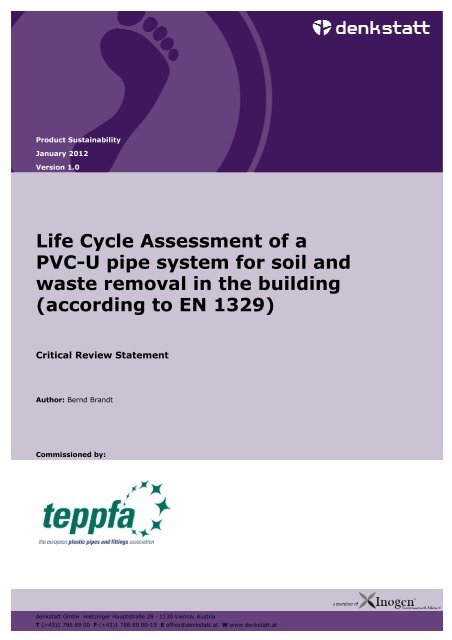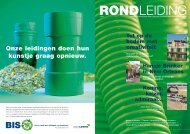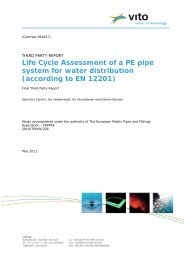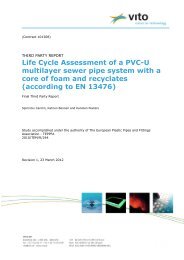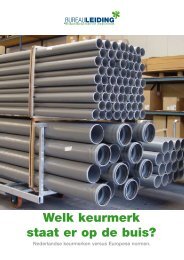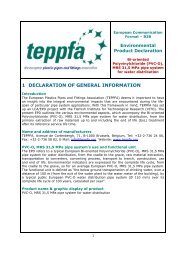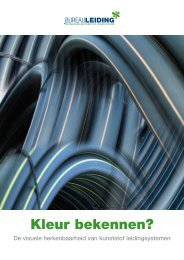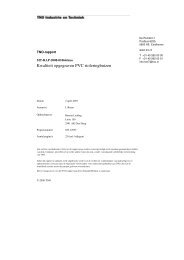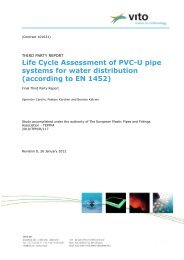Life Cycle Assessment of a PVC-U pipe system for ... - BureauLeiding
Life Cycle Assessment of a PVC-U pipe system for ... - BureauLeiding
Life Cycle Assessment of a PVC-U pipe system for ... - BureauLeiding
Create successful ePaper yourself
Turn your PDF publications into a flip-book with our unique Google optimized e-Paper software.
Product Sustainability<br />
January 2012<br />
Version 1.0<br />
<strong>Life</strong> <strong>Cycle</strong> <strong>Assessment</strong> <strong>of</strong> a<br />
<strong>PVC</strong>-U <strong>pipe</strong> <strong>system</strong> <strong>for</strong> soil and<br />
waste removal in the building<br />
(according to EN 1329)<br />
Critical Review Statement<br />
Author: Bernd Brandt<br />
Commissioned by:<br />
denkstatt GmbH Hietzinger Hauptstraße 28 · 1130 Vienna, Austria<br />
T (+43)1 786 89 00 F (+43)1 786 89 00-15 E <strong>of</strong>fice@denkstatt.at W www.denkstatt.at
Denkstatt_Critical_Review_<strong>PVC</strong>_soil&waste_Report_Vers.1.0<br />
TABLE OF CONTENTS<br />
1 Introduction 3<br />
2 Review Process 3<br />
3 Scientific Background 4<br />
4 Critical Review Findings 4<br />
5 Conclusion 5<br />
6 References 6<br />
denkstatt GmbH Page 2 <strong>of</strong> 6
Denkstatt_Critical_Review_<strong>PVC</strong>_soil&waste_Report_Vers.1.0<br />
1 Introduction<br />
The European Plastics Pipes and Fittings Association (TEPPFA) deems it important<br />
to have an insight into the integral environmental aspects encountered during the<br />
life-span <strong>of</strong> particular applications <strong>of</strong> plastic <strong>pipe</strong>s. With this framework in mind,<br />
TEPPFA commissioned a project which was carried out by the Flemish Institute <strong>for</strong><br />
Technological Research (VITO) in Belgium.<br />
The aim <strong>of</strong> this project was to carry out a life cycle assessment (LCA) consistent<br />
with [ISO 14040, 2006] and [ISO 14044, 2006] to analyse the environmental aspects<br />
which are associated with different plastic <strong>pipe</strong> <strong>system</strong>s.<br />
Summarised the objectives <strong>of</strong> the overall LCA-project <strong>for</strong> TEPPFA were:<br />
<br />
<br />
<br />
<br />
to analyse the environmental impacts <strong>of</strong> different applications <strong>of</strong> plastic<br />
<strong>pipe</strong> <strong>system</strong>s in selected application groups;<br />
to investigate the relative per<strong>for</strong>mance <strong>of</strong> various plastic <strong>pipe</strong> <strong>system</strong>s at<br />
the <strong>system</strong> level in order to show that material choices can not be made at<br />
the production level only;<br />
to use the results <strong>of</strong> the LCA-studies <strong>of</strong> the plastic <strong>pipe</strong> <strong>system</strong>s <strong>for</strong> business-to-business<br />
communication (via an EPD <strong>for</strong>mat);<br />
in a later stage and when relevant, the environmental pr<strong>of</strong>iles <strong>of</strong> TEPPFA<br />
products can be compared with other competing <strong>pipe</strong> <strong>system</strong>s.<br />
In a first phase the integral environmental impacts <strong>of</strong> 4 <strong>pipe</strong> <strong>system</strong>s were calculated<br />
by means <strong>of</strong> an LCA and later extended to 6 <strong>pipe</strong> <strong>system</strong>s.<br />
TEPPFA decided to further extend these LCA-studies up to 10 different <strong>pipe</strong> <strong>system</strong>s<br />
by considering 4 additional <strong>pipe</strong> <strong>system</strong>s:<br />
<br />
<br />
<br />
<br />
<strong>PVC</strong>-U and <strong>PVC</strong>-O <strong>pipe</strong> <strong>system</strong>s <strong>for</strong> water distribution<br />
Polymer multilayer <strong>pipe</strong> <strong>system</strong> <strong>for</strong> hot and cold water in the building<br />
<strong>PVC</strong> <strong>pipe</strong> <strong>system</strong> <strong>for</strong> soil and waste removal in the building<br />
PP multilayer <strong>pipe</strong> <strong>system</strong> <strong>for</strong> sewage<br />
Since TEPPFA plans to make the results <strong>of</strong> the LCA studies available <strong>for</strong> the general<br />
public, according to [ISO 14040, 2006] and [ISO 14044, 2006] a critical review <strong>of</strong><br />
the LCA study is required. This critical review was per<strong>for</strong>med by denkstatt GmbH.<br />
2 Review Process<br />
The critical review process <strong>of</strong> the 4 LCA studies described in section 1 was commissioned<br />
by The European Plastic Pipes and Fittings Association (TEPPFA). It was<br />
established in the timeframe <strong>of</strong> July 2011 to January 2012.<br />
After the receipt <strong>of</strong> the 4 draft LCA background reports from VITO (July 2011)<br />
denkstatt prepared a detailed list with review comments on methodological issues,<br />
assumptions made and data used. Furthermore general questions to support the<br />
comprehensibility <strong>of</strong> the report and specific recommendations <strong>for</strong> improvements <strong>of</strong><br />
the studies were included. VITO then had the time to consider suggestions made in<br />
denkstatt GmbH Page 3 <strong>of</strong> 6
Denkstatt_Critical_Review_<strong>PVC</strong>_soil&waste_Report_Vers.1.0<br />
the comments and compiled 4 draft final LCA background reports as well as 4 draft<br />
final third party reports.<br />
denkstatt’s critical review statement summarises the findings <strong>of</strong> the critical review<br />
and is based on those draft final LCA background reports, dated December 2011.<br />
The critical review statement will be included in the final version <strong>of</strong> the 4 LCA<br />
background reports as well as the 4 third party reports.<br />
3 Scientific Background<br />
The herein described critical review statement covers the study “<strong>Life</strong> <strong>Cycle</strong> <strong>Assessment</strong><br />
<strong>of</strong> a <strong>PVC</strong>-U <strong>pipe</strong> <strong>system</strong> <strong>for</strong> soil and waste removal in the building (according<br />
to EN 1329)”. It is based on the main guiding principles defined in the international<br />
standard series [ISO 14040, 2006] and [ISO 14044, 2006]. Thus, it<br />
should be noted that it is not the role <strong>of</strong> this critical review to endorse or dispute<br />
the goal <strong>of</strong> the study and the related conclusions. The aim was rather to examine<br />
that the:<br />
<br />
<br />
<br />
<br />
methods used are scientifically and technically valid <strong>for</strong> the given goal and<br />
scope <strong>of</strong> the study;<br />
data used are appropriate, sufficient and reasonable in respect to the goal<br />
and scope <strong>of</strong> the study;<br />
conclusions drawn reflect the goal and scope <strong>of</strong> the study and the limitations<br />
identified;<br />
reports are transparent and consistent.<br />
There<strong>for</strong>e, the findings <strong>of</strong> this review are discussed in accordance to the above<br />
mentioned guiding principles.<br />
The critical review did not involve a review <strong>of</strong> the calculations made in the study so<br />
that all the findings presented here are based solely on the draft (final) background<br />
report and the discussions with the authors <strong>of</strong> the study and TEPPFA.<br />
4 Critical Review Findings<br />
This particular LCA-study aims to examine the <strong>PVC</strong>-U <strong>pipe</strong> <strong>system</strong> <strong>for</strong> soil and<br />
waste removal in the building, to gather and assess comprehensive and reliable<br />
in<strong>for</strong>mation regarding the environmental per<strong>for</strong>mance <strong>of</strong> this <strong>pipe</strong> <strong>system</strong>, generated<br />
over its entire life cycle. At the same time, this study helps to provide a reliable<br />
database <strong>for</strong> the development <strong>of</strong> a Type III Environmental Product Declaration<br />
[ISO 14025, 2006] on the European level <strong>for</strong> the particular <strong>pipe</strong> <strong>system</strong>.<br />
The scope <strong>of</strong> the study was defined by the functional unit. The basic assumption<br />
was that the definition <strong>of</strong> the functional unit should represent the function <strong>of</strong> the<br />
<strong>PVC</strong>-U <strong>pipe</strong> <strong>system</strong> over its entire life cycle: raw material extraction, material production,<br />
production <strong>of</strong> the <strong>pipe</strong>s and fittings, the construction phase, the use phase<br />
and the processing <strong>of</strong> the waste at the end <strong>of</strong> life <strong>of</strong> the <strong>PVC</strong> <strong>pipe</strong>s and fittings. The<br />
functional unit <strong>of</strong> the <strong>PVC</strong>-U <strong>pipe</strong> <strong>system</strong> <strong>for</strong> soil and waste removal in the building<br />
has been defined as: “The gravity discharge and transport <strong>of</strong> soil and waste, from<br />
a well-defined apartment to the entrance <strong>of</strong> a public sewer <strong>system</strong>, and this by<br />
means <strong>of</strong> a <strong>PVC</strong>-U Soil and Waste gravity drainage <strong>system</strong> installation into the<br />
denkstatt GmbH Page 4 <strong>of</strong> 6
Denkstatt_Critical_Review_<strong>PVC</strong>_soil&waste_Report_Vers.1.0<br />
typical 100 m² apartment, incorporating a bathroom, separate WC, kitchen and<br />
washroom (considering the service life time <strong>of</strong> the <strong>pipe</strong> <strong>system</strong> to be aligned with<br />
the 50 year life <strong>of</strong> the apartment), calculated per year”.<br />
Based on this goal and scope <strong>of</strong> the project the following conclusions can be drawn<br />
from the review process:<br />
<br />
<br />
<br />
<br />
<br />
<br />
The widely accepted state-<strong>of</strong>-the-art methodology was adopted in this<br />
comprehensive LCA study and thus the study is scientifically and technically<br />
adequate. The authors <strong>of</strong> the study at VITO put a lot <strong>of</strong> ef<strong>for</strong>t into designing<br />
the <strong>system</strong> and gathering respective data to be able to give a thorough<br />
picture <strong>of</strong> the <strong>pipe</strong> <strong>system</strong> under investigation over its entire life cycle.<br />
Quality <strong>of</strong> required data and data sources as well as data collection procedures<br />
are appropriate, sufficient and reasonable. They are in accordance<br />
with the goal and scope <strong>of</strong> the study. <strong>Life</strong> cycle in<strong>for</strong>mation <strong>of</strong> the different<br />
materials used was taken from up-to-date literature and databases representing<br />
European conditions or directly from the respective industries.<br />
Within the study no sensitivity analyses were made, as according to the<br />
authors they would not have much added value. Keeping the goal and<br />
scope <strong>of</strong> the study in mind, the given arguments are reasonable.<br />
The background report is presented in a very detailed, well structured and<br />
also very transparent, consistent and logical manner. All assumptions, limitations<br />
and constraints are well described. Detailed explanations and justifications<br />
are given, whenever necessary, especially when certain negligible<br />
issues were not considered in the calculations.<br />
Most <strong>of</strong> the reviewer’s comments and recommendations to improve the<br />
study and to raise the clarity, transparency and consistency <strong>of</strong> the background<br />
report were considered by the authors. In some cases assumptions<br />
made by VITO in cooperation with the specific TEPPFA application group<br />
were discussed between VITO and the reviewer (e.g. regarding plausibility<br />
and representativeness within the given <strong>system</strong> boundaries). The reviewer<br />
accepts the chosen assumptions as the result <strong>of</strong> expert judgement<br />
achieved in several workshops.<br />
Additionally the authors compiled a third party report, where the results<br />
are summarised in a very clear and focused manner. This allows an interested<br />
party to get an overview <strong>of</strong> all results without reading the comprehensive<br />
background report, which due to its extensive size has rather to be<br />
considered as specific reference document <strong>for</strong> all the aspects examined.<br />
5 Conclusion<br />
This study is an LCA according to ISO standards series [ISO 14040, 2006] and<br />
[ISO 14044, 2006] and has fulfilled all necessary steps in an adequate and highly<br />
sufficient manner within the given goal <strong>of</strong> the study. All methodological steps reported<br />
are in accordance with this state-<strong>of</strong>-the-art approach.<br />
It can be concluded that this is a competent study, which gives a thorough picture<br />
about the environmental aspects <strong>of</strong> the plastic <strong>pipe</strong> <strong>system</strong> under investigation<br />
denkstatt GmbH Page 5 <strong>of</strong> 6
Denkstatt_Critical_Review_<strong>PVC</strong>_soil&waste_Report_Vers.1.0<br />
over its total life cycle from the cradle to the grave. The complete study has been<br />
established in a transparent, consistent and logical way.<br />
The third party report as the main document <strong>for</strong> the communication <strong>of</strong> the findings<br />
<strong>of</strong> this study presents the results in a clear, logical <strong>for</strong>m, thus making it easy to<br />
understand. I explicitly recommend that this in<strong>for</strong>mation should be communicated<br />
to the TEPPFA member companies and its National Associations as well as external<br />
stakeholders.<br />
6 References<br />
ISO 14025 (2006): International Organization <strong>for</strong> Standardization - Environmental<br />
labels and declarations - Type III environmental declarations - Principles and<br />
procedures. ISO 14025:2006.<br />
ISO 14040 (2006): International Organization <strong>for</strong> Standardization - Environmental<br />
management - <strong>Life</strong> cycle assessment - Principles and framework.<br />
ISO Standard 14040:2006.<br />
ISO 14044 (2006): International Organization <strong>for</strong> Standardization - Environmental<br />
management - <strong>Life</strong> cycle assessment – Requirements and Guidelines.<br />
ISO Standard 14044:2006.<br />
denkstatt GmbH Page 6 <strong>of</strong> 6


